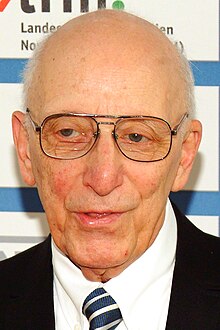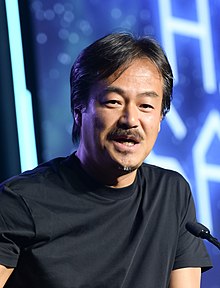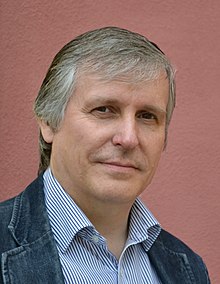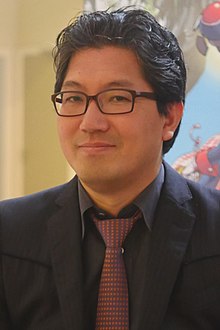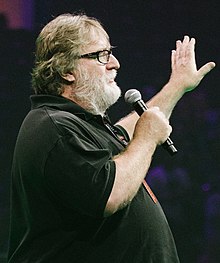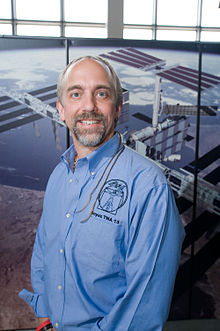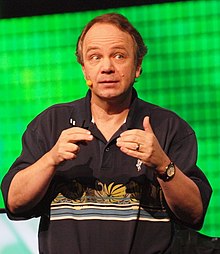Portal:Video games
Portal maintenance status: (April 2019)
|
The Video Games Portal

A video game, sometimes further qualified as a computer game, is an electronic game that involves interaction with a user interface or input device (such as a joystick, controller, keyboard, or motion sensing device) to generate visual feedback from a display device, most commonly shown in a video format on a television set, computer monitor, flat-panel display or touchscreen on handheld devices, or a virtual reality headset. Most modern video games are audiovisual, with audio complement delivered through speakers or headphones, and sometimes also with other types of sensory feedback (e.g., haptic technology that provides tactile sensations). Some video games also allow microphone and webcam inputs for in-game chatting and livestreaming.
Video games are typically categorized according to their hardware platform, which traditionally includes arcade video games, console games, and computer games (which includes LAN games, online games, and browser games). More recently, the video game industry has expanded onto mobile gaming through mobile devices (such as smartphones and tablet computers), virtual and augmented reality systems, and remote cloud gaming. Video games are also classified into a wide range of genres based on their style of gameplay and target audience. (Full article...)
Featured articles – load new batch
-
Image 1Myst V: End of Ages is a 2005 adventure video game, the fifth installment in the Myst series. The game was developed by Cyan Worlds, published by Ubisoft, and released for Macintosh and Windows PC platforms in September 2005. As in previous games in the series, End of Ages's gameplay consists of navigating worlds known as "Ages" via the use of special books and items which act as portals.
In a departure from previous titles in the Myst series, End of Ages replaces pre-rendered environments with worlds rendered in real-time 3D graphics, allowing players to freely navigate the Ages. The faces of actors were digitally mapped onto three-dimensional character models to preserve realism. The game also includes multiple methods of navigation and an in-game camera.
End of Ages was positively received, despite complaints such as lessened interactivity compared to previous games and poorer graphics. After End of Ages's release, Cyan abruptly announced the end of software development and the layoff of most of its staff, but was able to rehire much of the development team a few weeks later. (Full article...) -
Image 2Golden Sun is a role-playing video game developed by Camelot Software Planning and published by Nintendo for the Game Boy Advance. It was released in August 2001 in Japan, November 2001 in North America and February 2002 in Europe.
Golden Sun's story follows a band of magic-attuned teenagers called Adepts on a mission to protect the world of Weyard from alchemy, a potentially destructive power that was sealed away long ago. During their quest, the Adepts develop new magic abilities called Psynergy, assist others, and learn more about why alchemy was sealed away. Golden Sun is followed by a sequel, The Lost Age, which together form a complete story.
Golden Sun began as a single planned game for the Nintendo 64, but production shifted to the Game Boy Advance over the course of development. After facing hardware constraints, the developers decided to split the game into two. (Full article...) -
Image 3Mario Party DS is a 2007 party video game developed by Hudson Soft and published by Nintendo for the Nintendo DS. It is the second handheld game in the Mario Party series, as well as the last game in the series to be developed by Hudson Soft, as all subsequent titles have been developed by Nintendo Cube. The game was re-released on the Virtual Console for the Wii U in 2016.
Like most installments in the Mario Party series, Mario Party DS features characters from the Mario franchise competing in a board game with a variety of minigames, many of which utilize the console's unique features. Up to four human players can compete at a time, though characters can also be computer-controlled. The game features a single-player story mode as well as several other game modes.
Mario Party DS received mixed reviews, with general praise for its minigame variety and criticism for its absence of an online multiplayer mode. The game has sold more than nine million units worldwide, making it the 11th-best-selling game for the Nintendo DS. Mario Party DS was succeeded by Mario Party 9 for the Wii in 2012. (Full article...) -
Image 4The development of The Elder Scrolls IV: Oblivion began in 2002, immediately after its predecessor, The Elder Scrolls III: Morrowind, was published. Rumors of a sequel to Morrowind started circulating in June 2004; the sequel's title was identified on September 10, 2004, the date of its official announcement. Oblivion was developed by Bethesda Game Studios, and the initial Xbox 360 and personal computer (PC) releases were co-published by Bethesda Softworks and Take-Two Interactive's subsidiary, 2K Games. According to interviews with Bethesda staff, the publisher-developer relationship—one of the few independent relations in the industry—worked well, and Bethesda was not subject to excessive corporate guidance. Initially scheduled for a November 22, 2005, release, in tandem with the Xbox 360's launch, Oblivion was delayed to a March 21, 2006, release for Windows PCs and the Xbox 360.
Developers working on Oblivion focused on providing a tighter storyline, with fewer filler quests and more developed characters. The developers sought to make information in the game world more accessible to players, making the game easier to pick up and play. Oblivion features improved AI (which Bethesda calls Radiant AI), improved physics courtesy of the Havok physics engine, and impressive graphics, taking advantage of advanced lighting and shader routines like high-dynamic-range rendering (HDR) and specular mapping. Bethesda developed and implemented procedural content creation tools in the creation of Oblivion's terrain, leading to landscapes that are more complex and realistic than those of past titles, with less of a drain on Bethesda's staff.
A PlayStation 3 version of Oblivion was released on March 20, 2007, in North America, and April 27, 2007, in Europe, following delays similar to those for the Xbox 360 release. The PlayStation 3 release was touted for its improvement over the graphics of the PC and Xbox 360 versions, although some of the improved shader routines optimized for the PlayStation 3 release were set to be ported over to the other releases through patches. A plan to distribute content through downloads paid by micropayment was initially met with criticism by customers due to its alleged low value, but later releases—at a reduced price, and with more content—proved more popular. (Full article...) -
Image 5Mario & Sonic at the Olympic Games is a 2007 crossover sports and party game developed by the Sega Sports R&D Department. It is the first installment on the Mario & Sonic series. It was published by Nintendo in Japan and by Sega in other regions, and released on the Wii in November 2007 and the Nintendo DS handheld in January 2008. The first official video game of the 2008 Summer Olympic Games, it is licensed by the International Olympic Committee (IOC) through exclusive licensee International Sports Multimedia (ISM), and is the first official crossover game to feature characters from the Mario and Sonic the Hedgehog series.
Mario & Sonic on the Wii and DS is a collection of twenty-four events based on the Olympic Games. Players assume the role of a Nintendo or Sega character, using the Wii Remote to mimic sports actions such as swinging a paddle. The DS version uses the stylus and button controls. Both games follow rules and regulations of the specific sports. Sega adopted the IOC's mission of promoting sportsmanship and interest young people in the Olympics by using its characters; following this theme, Nintendo allowed Sega to include Mario with Sonic the Hedgehog, created by Sega as a mascot to rival Mario in the early 1990s.
Critics praised the multiplayer interaction of the Wii game, and variety of events of both versions, but criticized the Wii version for its complexity and its DS counterpart for not offering the same interaction between players. The Wii game was awarded the "Best Wii game of 2007" at the Games Convention in Leipzig. Mario & Sonic sold over 10 million units and started a series of related sport video games to coincide with upcoming Olympic events. (Full article...) -
Image 6Final Fantasy X-2 is a 2003 role-playing video game developed and published by Square for the PlayStation 2. Unlike most Final Fantasy games, which use self-contained stories and characters, X-2 continues the story of Final Fantasy X (2001). The story follows Yuna as she searches for Tidus, the main character of the previous game, while trying to prevent political conflicts in Spira from escalating to war.
Final Fantasy X-2 was the first game in the series to feature just three player characters and an all-female main cast. The battle system incorporates Final Fantasy character classes—one of the series' signature gameplay concepts—and is one of the few entries to have multiple possible endings. The soundtrack was created by Noriko Matsueda and Takahito Eguchi in lieu of long-time Final Fantasy composer Nobuo Uematsu.
The game was positively received by critics and was commercially successful, selling over 5.4 million copies on PlayStation 2 and winning a number of awards. It was the last Final Fantasy game to be released by Square before it merged with Enix in April 2003. The game was re-released in high-definition for the PlayStation 3 and PlayStation Vita in 2013, alongside Final Fantasy X, as Final Fantasy X/X-2 HD Remaster; this version was later released for the PlayStation 4 in 2015, Windows in 2016, and the Nintendo Switch and Xbox One in 2019. As of September 2021, the Final Fantasy X series had sold over 20.8 million units worldwide, and at the end of March 2022 had surpassed 21.1 million units sold around the world. (Full article...) -
Image 7Guitar Hero is a 2005 rhythm game developed by Harmonix and published by RedOctane for the PlayStation 2. It is the first installment in the Guitar Hero series. Guitar Hero was released in November 2005 in North America, April 2006 in Europe and June 2006 in Australia. The game's development was a result of collaboration between RedOctane and Harmonix to bring a Guitar Freaks-like game to United States.
The game features a guitar-shaped controller (resembling a miniature Gibson SG) that the player uses to simulate playing rock music. The gameplay is similar to GuitarFreaks, in that the player presses buttons on the guitar controller in time with musical notes that scroll on the game screen. The game features covers of 30 popular rock songs spanning five decades of rock, from the 1960s up through 2005, in addition to bonus tracks. Guitar Hero became a surprise hit, earning critical acclaim and winning many awards from major video game publications, and is considered one of the most influential games of its decade. The game's success launched the Guitar Hero franchise, which has earned more than $2 billion in sales, spawning several sequels, expansions, and other game-related products. (Full article...) -
Image 8Terra Nova: Strike Force Centauri is a 1996 tactical first-person shooter video game developed and published by LookingGlass Technologies. Set in a science-fictional depiction of the 24th century, the game follows a faction of humans who colonize the Alpha Centauri star system to escape from the Hegemony, a totalitarian Earth government. The player assumes the role of Nikola ap Io, the leader of an Alpha Centauri military unit, and undertakes missions against pirates and the Hegemony.
Terra Nova has been cited as one of the first squad-oriented games with three-dimensional (3D) graphics; the player is often assisted by artificially intelligent teammates who may be given tactical commands. Conceived by Looking Glass after the completion of their first game, Ultima Underworld: The Stygian Abyss, Terra Nova was subject to a long and difficult development process, caused in part by the production of its full-motion video cutscenes. The game's TED engine can render 3D outdoor environments and simulate physics; the latter enables such effects as procedural animation.
Terra Nova's critical reception was highly positive. Reviewers praised its tactical elements, and several compared it to the 1995 video game MechWarrior 2: 31st Century Combat. However, reception of its graphics was mixed, and many noted the game's steep system requirements. Despite critical acclaim and sales in excess of 100,000 units, the game was a commercial failure: it did not recoup its development costs. While it was intended to be the first in a series, its low sales led the company to cancel plans for a sequel. (Full article...) -
Image 9Kingdom Two Crowns is a 2018 strategy video game developed by Thomas van den Berg and Coatsink and published by Raw Fury. It is the third entry in the Kingdom series. Players control a mounted monarch as they attempt to defend their kingdom from a race of monsters called the Greed. The monarch can recruit villagers to perform certain jobs while building defenses such as towers and walls to fend off waves of Greed attacking the kingdom at night. Kingdom Two Crowns features single-player and cooperative multiplayer modes, with cooperative play enabling two monarchs to join via a split screen.
The developers originally designed Kingdom Two Crowns as an expansion pack for Kingdom: New Lands (2016). As the expansion grew, they decided to release it as a separate game. The series' creator, van den Berg, wanted to develop a new experience centered around defending structures. The developers chose to lessen the difficulty of the previous games' roguelike mechanics, and used a pixel art style to reduce the time between drawing and implementing new designs in gameplay.
Kingdom Two Crowns was released for Windows, macOS, PlayStation 4, Nintendo Switch, and Xbox One on December 11, 2018, and for iOS and Android on April 28, 2020. It received positive reviews, gaining praise for its strategic gameplay, artwork, and cooperative play, though its slow pace was criticized. The game attracted over 300,000 players within six months of launch, and was supported by Raw Fury with several updates and downloadable content. (Full article...) -
Image 10Cave Story is a 2004 Metroidvania platform-adventure video game for Microsoft Windows. It was developed over five years by Japanese independent developer Daisuke "Pixel" Amaya in his free time. Cave Story features 2D platform mechanics and is reminiscent of the games Amaya played in his youth, such as Metroid and Castlevania. After its initial self-published release, the game slowly gained popularity on the internet. It received widespread critical acclaim for many polished aspects of its design, such as its compelling characters, setting, story, and gameplay. Cave Story is considered by many as the quintessential indie game because of its one-person development team and influence on the video gaming world.
Independent video game developer Nicalis worked with Amaya to port the game to WiiWare and DSiWare in 2010. An enhanced version, Cave Story+, was released for Steam in November 2011, and the original game was released for the Nintendo 3DS in October 2012 with added content. A 3D remake of the game, titled Cave Story 3D, was developed by Nicalis and published by NIS America for the Nintendo 3DS in November 2011. A port of Cave Story+ for the Nintendo Switch was released in June 2017.
Cave Story revolves around Quote, a robot who wakes up suffering from amnesia and explores in diverse cavernous areas in order to uncover his backstory and escape from the cave. The character gains access to new areas as he powers up his weapons by collecting triangular experience crystals and solves various platforming puzzles. Quote speaks to non-player characters scattered around the game world in order to learn more about the world and its inhabitants. (Full article...)
Did you know... - show different entries
- ... that Rockstar Vienna was the largest video game developer in Austria when it closed in 2006?
- ... that the 1979 video game Superman was one of the first console games with a pause feature?
- ... that development on the video game Expeditions: Rome was not affected by lockdowns from the COVID-19 pandemic because the developer was already split between Copenhagen and Istanbul?
- ... that the video game mode Ultimate Team has been criticized for its reliance on loot box packs, considered to be a controversial form of gambling?
- ... that Kainé from the video game series Nier was created in response to a female staff member's vague wish for a "male heroine"?
- ... that the name of the video game mod series Bomba Patch was inspired by éclairs?
- ... that classified documents of the United States were partially leaked onto a Discord server for the video game Minecraft?
- ... that the science-fiction video game The Anacrusis is named after a musical term?
- ... that the team developing the action video game Knights Contract researched European folklore on witches and witch hunts?
- ... that the video game Serious Sam: Tormental was originally inspired by Geometry Wars?
- ... that the video game JFK Reloaded recreates the assassination of John F. Kennedy from the perspective of the killer?
- ... that players of the simulation video game Overcrowd: A Commute 'Em Up need to manage everything from the construction of train stations to dumping trash cans?
Selected biography – load new batch
-
Image 1Satoru Iwata (Japanese: 岩田 聡, Hepburn: Iwata Satoru, December 6, 1959 – July 11, 2015) was a Japanese businessman, video game programmer, video game designer, and producer. He was the fourth president and chief executive officer (CEO) of Nintendo from 2002 until his death in 2015. Iwata was a major contributor in broadening the appeal of video games by focusing on novel and entertaining games rather than top-of-the-line hardware.Iwata at Game Developers Conference in 2011
Born in Sapporo, Iwata expressed interest in video games from an early age and created his first simple game while in high school. He majored in computer science at the Tokyo Institute of Technology. In 1980, he joined the game developer HAL Laboratory while attending the university. At HAL, he worked as a programmer and closely collaborated with Nintendo, producing his first commercial game in 1983. Games to which he contributed include EarthBound and many games in the Kirby series. Following a downturn and near-bankruptcy, Iwata became the president of HAL in 1993 at the insistence of Nintendo president Hiroshi Yamauchi and brought financial stability. In the following years, he worked in the development of the Pokémon and Super Smash Bros. series. Iwata joined Nintendo as the head of its corporate planning division in 2000. (Full article...) -
Image 2
Mark Edward Fischbach (/ˈfɪʃˌbɑːk/ FISH-bahk; born June 28, 1989), known online as Markiplier, is an American YouTuber, actor, filmmaker, and influencer. One of the most popular YouTubers on the platform, he is known for his "Let's Play" videos of indie horror games. He was listed by Forbes as the third highest-paid content creator on the platform in 2022, and has won four Streamy Awards and a Golden Joystick Award. He has spun off his YouTube fame into a media career, venturing into acting and filmmaking.
After joining YouTube in 2012, Fischbach became popular on the platform with Let's Plays of Amnesia: The Dark Descent (2010) and the Five Nights at Freddy's series; as of 2024, his channel had over 37 million subscribers. He signed with talent agency William Morris Endeavor in 2016. While with the agency, he released a clothing line, wrote and directed the YouTube Original series A Heist with Markiplier (2019) and In Space with Markiplier (2022), and hosted or co-hosted two podcasts which reached No. 1 on Spotify. (Full article...) -
Image 3Hiroshi Yamauchi (山内溥, Yamauchi Hiroshi, 7 November 1927 – 19 September 2013) was a Japanese businessman and the third president of Nintendo, joining the company on 25 April 1949 until stepping down on 24 May 2002, being succeeded by Satoru Iwata. During his 53-year tenure, Yamauchi transformed Nintendo from a hanafuda card-making company that had been active solely in Japan into a multibillion-dollar video game publisher and global conglomerate. He was the great-grandson of Fusajiro Yamauchi, Nintendo's first president and founder. Hiroshi Yamauchi owned the Seattle Mariners baseball team from 1992 until his death.
In April 2013, Forbes estimated Yamauchi's net worth at $2.1 billion; he was the 13th richest person in Japan and the 491st richest in the world. In 2008, Yamauchi was Japan's wealthiest person with a fortune at that time estimated at $7.8 billion. At the time of his death, Yamauchi was the largest shareholder at Nintendo. (Full article...) -
Image 4Hideo Kojima (小島 秀夫, Kojima Hideo, born August 24, 1963) is a Japanese video game designer. Regarded as one of the first auteurs of video games, he developed a strong passion for film and literature during his childhood and adolescence, which in turn has had a significant influence on his games. In 1986, Kojima joined Konami, for which he directed, designed and wrote Metal Gear (1987) for the MSX2, the game that laid the foundations for the stealth genre and the Metal Gear franchise, his best known and most acclaimed work. At Konami, he also produced the Zone of the Enders series, as well as designing and writing Snatcher (1988) and Policenauts (1994), graphic adventure games regarded for their cinematic presentation.
Kojima founded Kojima Productions within Konami in 2005, and he was appointed vice president of Konami Digital Entertainment in 2011. Following his departure from Konami in 2015, he refounded Kojima Productions as an independent studio; his first game outside Konami, Death Stranding, was released in 2019. (Full article...) -
Image 5Nobuo Uematsu (植松 伸夫, Uematsu Nobuo, born March 21, 1959) is a Japanese composer and keyboardist best known for his contributions to the Final Fantasy video game series by Square Enix. A self-taught musician, he began playing the piano at the age of twelve, with English singer-songwriter Elton John as one of his biggest influences in pursuing a musical career.
Uematsu joined Square in 1986, where he first met Final Fantasy creator Hironobu Sakaguchi. The two later worked together on many games at the company, most notably in the Final Fantasy series. After nearly two decades with Square, Uematsu left in 2004 to create his own production company and music label, Dog Ear Records. He has since composed music as a freelancer for other games, including ones developed by Square Enix and Sakaguchi's studio Mistwalker. (Full article...) -
Image 6Morhaime at BlizzCon 2009
Michael Morhaime (born November 3, 1967) is an American video game developer and entrepreneur. He is the chief executive officer (CEO) and founder of Dreamhaven, located in Irvine, California. Morhaime is best known as the co-founder and the former president of Blizzard Entertainment, a subsidiary of Activision Blizzard, Inc., that was founded in 1991 as Silicon & Synapse. He served on the Vivendi Games executive committee from January 1999, when Blizzard Entertainment, Inc. became a subsidiary of Vivendi Games, until July 2008. (Full article...) -
Image 7Wright speaking at the 2010 Game Developers Conference
William Ralph Wright (born January 20, 1960) is an American video game designer and co-founder of the game development company Maxis, which later became part of Electronic Arts. In April 2009, he left EA to run Stupid Fun Club Camp, an entertainment think tank in which Wright and EA are principal shareholders.
The first computer game Wright designed was Raid on Bungeling Bay in 1984, but it was SimCity that brought him to prominence. The game was published by Maxis, which Wright co-formed with Jeff Braun. Wright continued to innovate on the game's central theme of simulation with numerous other titles including SimEarth and SimAnt. (Full article...) -
Image 8
Todd Andrew Howard (born 1970) is an American video game designer, director, and producer. He serves as director and executive producer at Bethesda Game Studios, where he has led the development of the Fallout and The Elder Scrolls series. He was also the game director for Starfield. (Full article...) -
Image 9
Ralph Henry Baer (born Rudolf Heinrich Baer; March 8, 1922 – December 6, 2014) was an American inventor, game developer, and engineer.
Baer's Jewish family fled Germany just before World War II and Baer served the American war effort, gaining an interest in electronics shortly thereafter. Through several jobs in the electronics industry, he was working as an engineer at Sanders Associates (now BAE Systems) in Nashua, New Hampshire, when he conceived the idea of playing games on a television screen around 1966. With support of his employers, he worked through several prototypes until he arrived at a "Brown Box" that would later become the blueprint for the first home video game console, licensed by Magnavox as the Magnavox Odyssey. Baer continued to design several other consoles and computer game units, including contributing to design of the Simon electronic game. Baer continued to work in electronics until his death in 2014, with over 150 patents to his name. (Full article...) -
Image 10Hironobu Sakaguchi (坂口 博信, Sakaguchi Hironobu, born November 25, 1962) is a Japanese game designer, director, producer, and writer. Originally working for Square (later Square Enix) from 1983 to 2003, he departed the company and founded independent studio Mistwalker in 2004. He is known as the creator of the Final Fantasy franchise, in addition to other titles during his time at Square. At Mistwalker, he is known for creating the Blue Dragon and Terra Battle series among several standalone titles, moving away from home consoles and creating titles for mobile platforms.Sakaguchi at the 2015 Game Developers Choice Awards
Originally intending to become a musician, he briefly studied electronics and programming, joining Square as a part-time employee, then later a full-time employee when Square became an independent company in 1986. He led the development of several titles before helping to create the original Final Fantasy, which proved highly successful and cemented his status within the company. Following the financial failure of Final Fantasy: The Spirits Within, his debut as a film director, Sakaguchi withdrew from Square's management and eventually resigned in 2003. He continued his game career through Mistwalker, first co-developing projects through external partners and then smaller in-studio mobile projects. (Full article...) -
Image 11
Richard Allan Bartle (born 10 January 1960) is a British writer, professor and game researcher in the massively multiplayer online game industry. He co-created MUD1 (the first MUD) in 1978, and is the author of the 2003 book Designing Virtual Worlds. (Full article...) -
Image 12Yuji Naka (中 裕司, Naka Yūji, born September 17, 1965), credited in some games as YU2, is a Japanese video game developer. He is the co-creator of the Sonic the Hedgehog series and was the president of Sonic Team at Sega until his departure in 2006.
Naka joined Sega in 1984 and worked on games including Girl's Garden (1985) and Phantasy Star II (1989). He was the lead programmer of the original Sonic games on the Mega Drive in the early 1990s, which greatly increased Sega's market share. After developing Sonic the Hedgehog (1991) in Japan, Naka moved to California to develop Sonic the Hedgehog 2 (1992), Sonic the Hedgehog 3 (1994) and Sonic & Knuckles (1994) with Sega Technical Institute. (Full article...) -
Image 13
Timothy John Schafer (born July 26, 1967) is an American video game designer. He founded Double Fine Productions in July 2000, after having spent over a decade at LucasArts. Schafer is best known as the designer of critically acclaimed games Full Throttle, Grim Fandango, Psychonauts, Brütal Legend and Broken Age, co-designer of Day of the Tentacle, and assistant designer on The Secret of Monkey Island and Monkey Island 2: LeChuck's Revenge. He is well known in the video game industry for his storytelling and comedic writing style, and has been given both a Lifetime Achievement Award from the Game Developers Choice Awards, and a BAFTA Fellowship for his contributions to the industry. (Full article...) -
Image 14
Gabe Logan Newell (born November 3, 1962), also known by his nickname Gaben, is an American video game developer and businessman. He is the president and co-founder of the video game company Valve Corporation.
Newell was born in Colorado and grew up in Davis, California. He attended Harvard University in the early 1980s but dropped out to join Microsoft, where he helped create the first versions of the Windows operating system. In 1996, he and Mike Harrington left Microsoft to found Valve and fund the development of their first game, Half-Life (1998). Harrington sold his stake in Valve to Newell and left in 2000. Newell led the development of Valve's digital distribution service, Steam, which launched in 2003 and controlled most of the market for downloaded PC games by 2011. (Full article...) -
Image 15Romero at the Game Developers Conference in 2022
Alfonso John Romero (born October 28, 1967) is an American video game developer. He co-founded id Software and designed their early games, including Wolfenstein 3D (1992), Doom (1993), Doom II (1994), Hexen (1995) and Quake (1996). His designs and development tools, along with programming techniques developed by the id programmer John Carmack, popularized the first-person shooter (FPS) genre. Romero is also credited with coining the multiplayer term "deathmatch".
Following disputes with Carmack, Romero was fired from id in 1996. He co-founded a new studio, Ion Storm, and directed the FPS Daikatana (2000), which was a critical and commercial failure. Romero departed Ion Storm in 2001. In July 2001, he and another former id employee, Tom Hall, founded Monkeystone Games to develop games for mobile devices. (Full article...) -
Image 16
Felix Arvid Ulf Kjellberg (/ˈʃɛlbɜːrɡ/ SHEL-burg, Swedish: [ˈfěːlɪks ˈǎrːvɪd ɵlf ˈɕɛ̂lːbærj] ⓘ; born 24 October 1989), better known as PewDiePie (/ˈpjuːdiːpaɪ/ PEW-dee-py), is a Swedish YouTuber known for his comedic videos. Kjellberg's popularity on YouTube and extensive media coverage has made him one of the most noted online personalities and content creators. He has been portrayed in media as a figurehead for YouTube, especially in the genre of gaming.
Born and raised in Gothenburg, Kjellberg registered his YouTube channel "PewDiePie" in 2010, primarily posting Let's Play videos of horror and action video games. His channel gained a substantial following and was one of the fastest growing channels in 2012 and 2013, before becoming the most-subscribed on YouTube on 15 August 2013. From 29 December 2014 to 14 February 2017, Kjellberg's channel was also the most-viewed on the platform. During this period, his content shifted focus from Let's Plays and diversified to include vlogs, comedy shorts, formatted shows, and music videos. (Full article...) -
Image 17

Nolan North (born October 31, 1970) is an American actor best known for his voice acting roles.
After his breakthrough role as Dr. Chris Ramsey on the ABC soap opera Port Charles in 1997, North moved into voice acting when the show ended in 2003 and has since become best known for his video game roles as Nathan Drake in the Uncharted series, Desmond Miles in the Assassin's Creed series, Merasmus in Team Fortress 2, the Prince in Prince of Persia, Dr. Edward Richtofen in the Call of Duty franchise, Deadpool in various Marvel Comics media, the Penguin in the Batman: Arkham franchise, Captain Martin Walker in Spec Ops: The Line, David in The Last of Us, himself as one of the voices for the player character in Saints Row IV, Tony Stark in Marvel's Avengers, and Ghost in the Destiny video game series. (Full article...) -
Image 18Shigeru Miyamoto (Japanese: 宮本 茂, Hepburn: Miyamoto Shigeru, born November 16, 1952) is a Japanese video game designer, producer and game director at Nintendo, where he serves as one of its representative directors as an executive since 2002. Widely regarded as one of the most accomplished and influential designers in video games, he is the creator of some of the most acclaimed and best-selling game franchises of all time, including Mario, The Legend of Zelda, Donkey Kong, Star Fox and Pikmin. More than 1 billion copies of games featuring franchises created by Miyamoto have been sold.
Born in Sonobe, Kyoto, Miyamoto graduated from Kanazawa Municipal College of Industrial Arts. He originally sought a career as a manga artist, until developing an interest in video games. With the help of his father, he joined Nintendo in 1977 after impressing the president, Hiroshi Yamauchi, with his toys. He helped create art for the arcade game Sheriff, and was later tasked with designing a new arcade game, leading to the 1981 game Donkey Kong. (Full article...) -
Image 19Tomohiro Nishikado (西角 友宏, Nishikado Tomohiro, born March 31, 1944) is a Japanese video game developer and engineer. He is the creator of the arcade shoot 'em up game Space Invaders, released to the public in 1978 by the Taito Corporation of Japan, often credited as the first shoot 'em up and for beginning the golden age of arcade video games. Prior to Space Invaders, he also designed other earlier Taito arcade games, including the shooting electro-mechanical games Sky Fighter (1971) and Sky Fighter II, the sports video game TV Basketball in 1974, the vertical scrolling racing video game Speed Race (also known as Wheels) in 1974, the multi-directional shooter Western Gun (also known as Gun Fight) in 1975, and the first-person combat flight simulator Interceptor (1975). (Full article...)
-
Image 20
Steven Scott Ritchie (born February 13, 1950) is an American pinball and video game designer. His career began in the 1970s. Ritchie holds the record for best-selling pinball designer in history. He has been called "The Master of Flow" due to the emphasis in his designs on ball speed, loops, and long smooth shots. Ritchie was also the original voice of Shao Kahn in the Mortal Kombat fighting game series, serving as the announcer of Mortal Kombat II (1993), Mortal Kombat 3 (1995), and the updates to Mortal Kombat 3. He is the older brother of fellow pinball designer Mark Ritchie. (Full article...) -
Image 21Daigo Umehara (Japanese: 梅原 大吾, Hepburn: Umehara Daigo, born 19 May 1981) is a Japanese esports player and author who competes competitively at fighting video games. He specializes in 2D arcade fighting games, mainly those released by Capcom. Known as "Daigo" or "The Beast" in the West and "Umehara" (ウメハラ, written in katakana instead of kanji) or "Ume" in Japan, Daigo is one of the world's most famous Street Fighter players and is often considered its greatest. His longevity is seen as an incredibly rare thing in the world of competitive video games. He currently holds a world record of "the most successful player in major tournaments of Street Fighter" in the Guinness World Records and is a six time Evo Championship Series winner.
Before properly being called a pro gamer from signing a sponsorship deal with Mad Catz, Japanese media usually referred to Daigo as "the god of 2D fighting games" (2D格闘ゲームの神, 2D Kakutō Gēmu no Kami). (Full article...) -
Image 22
Richard Allen Garriott (born 4 July 1961) is a British-born American video game developer, entrepreneur and private astronaut.
Garriott, who is the son of NASA astronaut Owen Garriott, was originally a game designer and programmer, and is now involved in a number of aspects of computer-game development. On October 12, 2008, Garriott flew aboard the Soyuz TMA-13 mission to the International Space Station as a private astronaut, returning 12 days later aboard Soyuz TMA-12. He became the second space traveler, and first from the United States, to have a parent who was also a space traveler. During his ISS flight, he filmed a science fiction movie Apogee of Fear. (Full article...) -
Image 23
John Bruce Thompson (born July 25, 1951) is an American activist and disbarred attorney. As an attorney, Thompson focused his legal efforts against what he perceives as obscenity in modern culture. Thompson gained recognition as an anti-video game activist, criticizing the content of video games and their alleged effects on children. He also targeted rap music and radio personality Howard Stern.
Thompson's legal career was further recognized for his actions against the Florida Bar, including challenging its constitutionality in 1993. In 2008, he was permanently disbarred by the Supreme Court of Florida for inappropriate conduct, including making false statements to tribunals and disparaging and humiliating litigants. (Full article...) -
Image 24Meier at the 2010 Game Developers Conference
Sidney K. Meier (/ˈmaɪər/ MIRE; born February 24, 1954) is an American businessman and computer programmer. A programmer, designer, and producer of several strategy video games and simulation video games, including the Civilization series, Meier co-founded MicroProse in 1982 with Bill Stealey and is the Director of Creative Development of Firaxis Games, which he co-founded with Jeff Briggs and Brian Reynolds in 1996. For his contributions to the video game industry, Meier was inducted into the Academy of Interactive Arts and Sciences Hall of Fame. (Full article...) -
Image 25Yuji Naka (中 裕司, Naka Yūji, born September 17, 1965), credited in some games as YU2, is a Japanese video game developer. He is the co-creator of the Sonic the Hedgehog series and was the president of Sonic Team at Sega until his departure in 2006.
Naka joined Sega in 1984 and worked on games including Girl's Garden (1985) and Phantasy Star II (1989). He was the lead programmer of the original Sonic games on the Mega Drive in the early 1990s, which greatly increased Sega's market share. After developing Sonic the Hedgehog (1991) in Japan, Naka moved to California to develop Sonic the Hedgehog 2 (1992), Sonic the Hedgehog 3 (1994) and Sonic & Knuckles (1994) with Sega Technical Institute. (Full article...)
Selected image - show another
Recent video game-related events
- January 16, 2025 –
- Nintendo officially reveals the Nintendo Switch 2 video game console, the successor to the Nintendo Switch. (Nintendo)
- September 12, 2024 – 2023–2024 video game industry layoffs
- Microsoft announces that it will lay off 650 Microsoft Gaming employees as part of cuts to its workforce. (Variety)
- August 15, 2024 –
- American video game magazine Game Informer discontinues publication after 33 years. The magazine's website is also shut down. (BBC News)
Topics
Early history of video games (1947-1971) | |
|---|---|
| Analog and lightbulb games |
|
| Early Chess programs |
|
| Early mainframe games |
|
| First arcade games |
|
| People | |
| By platform | |
|---|---|
| By console generation | |
Video games by platform | |||||
|---|---|---|---|---|---|
| |||||
| Action |
| ||||||||||
|---|---|---|---|---|---|---|---|---|---|---|---|
| Action-adventure | |||||||||||
| Adventure | |||||||||||
| Digital tabletop | |||||||||||
| Puzzle | |||||||||||
| Role-playing | |||||||||||
| Simulation |
| ||||||||||
| Strategy | |||||||||||
| Other genres | |||||||||||
| Related concepts |
| ||||||||||
Video games by country | |
|---|---|
| Africa | |
| Americas | |
| Asia | |
| Europe | |
| Oceania | |
Best-selling video game hardware and software | |||||||||
|---|---|---|---|---|---|---|---|---|---|
| General | |||||||||
| Best-selling video games by platform |
| ||||||||
Video game concepts | |
|---|---|
| Attributes | |
| Characters | |
| Mechanics |
|
| Scenery | |
| Movement techniques | |
| Forms of play | |
| Game modes | |
Featured topics
Related portals
Categories
Things you can do
|
AfDs
Merge discussions
|
Other discussions
No major discussions
Good article nominations
DYK nominations
|
Articles that need...
| |
In other Wikimedia projects
The following Wikimedia Foundation sister projects provide more on this subject:
-
Commons
Free media repository -
Wikibooks
Free textbooks and manuals -
Wikidata
Free knowledge base -
Wikinews
Free-content news -
Wikiquote
Collection of quotations -
Wikisource
Free-content library -
Wikiversity
Free learning tools -
Wiktionary
Dictionary and thesaurus
- Pages using the Phonos extension
- Pages with Swedish IPA
- Pages including recorded pronunciations
- Portals with triaged subpages from April 2019
- All portals with triaged subpages
- Portals with no named maintainer
- Automated article-slideshow portals with 201–500 articles in article list
- Automated article-slideshow portals with less than 2 articles in article list
- Random portal component with over 50 available image subpages
- Pages using div col with small parameter
- Portals needing placement of incoming links
- Redirect targets of redirected portals with existing subpages









